Guide to preparing a statement of owner’s equity
Content

We have attached the referenced examples in the excel sheet attached with this file, and in total, there are two examples in two different tabs. What’s important is that the beginning and ending balances of the owner’s equity should reconcile with the balance sheet.

Or if there is a panic selling by the investors either based on rumors or at the instance of the competitors. Then the company management can make a decision to buy back part of the floating shares, thereby providing value to the shareholders.
Increasing Owners Equity through Retained Earnings
For instance, those who gave a loan to the company would want to know how the company is maintaining the minimum equity levels to meet the debt agreements. This metric is frequently used by analysts and investors to determine a company’s general financial health. IT systems, vehicles, machinery and other assets sometimes come with hidden costs that exceed their purchase price. Learn Total Cost of Ownership Analysis from the premier on-line TCO article, expose the hidden costs in potential acquisitions, and be confident you are making sound purchase decisions. The complete, concise guide to winning business case results in the shortest possible time.

It reconciles the beginning owner’s equity to ending owner’s equity, which both must agree to the owner’s equity amount shown on the beginning and ending balance sheet. This financial statement isn’t common in small business accounting software. This figure is calculated by subtracting total liabilities from total assets; alternatively, it can be calculated by taking the sum of share capital and retained earnings, less treasury stock. A balance sheet provides a snapshot of a company’s financial situation at a particular time, typically at the end of a quarter or year. This document presents itemized lists of the company’s assets and liabilities. By subtracting the total liabilities from the total assets, the company can calculate the owner’s equity. The owner’s equity shows the available capital that the owner could claim if all assets were sold and all liabilities were paid at that particular date and time.
Statement of Changes in Equity
The result of this calculation represents the company’s total liabilities. A statement of owner’s equity is a report detailing changes in company equity over a specific accounting period or the total value of assets held by the company after deducting all liabilities. The statement of owner’s equity is a financial statement that shows the changes in owner’s equity items during the period.
Is owner’s equity a debit or credit?
Equity, or owner's equity, is generally what is meant by the term “book value,” which is not the same thing as a company's market value. Equity accounts normally carry a credit balance, while a contra equity account (e.g. an Owner's Draw account) will have a debit balance.
Generally, increasing owner’s equity from year to year indicates a business is successful. Just make sure that the increase is due to profitability rather than owner contributions keeping the business afloat. Owner’s equity is calculated by adding up all of the business assets and deducting all of its liabilities. It represents the owner’s claims to what would be leftover if the business sold all of its assets and paid off its debts. An equity statement is a financial statement that a company is required to prepare along with other important financial documents at the end of the financial year.
Gain visibility into cash flow and spend with Ramp
Alex’s company has total assets of $600,000 and owner’s equity of $230,000. The statement of changes in equity reports changes in the equity accounts for a corporation.
- Such withdrawals and reductions to Owners equity are much rarer in public companies with large numbers of shareholders.
- And to conserve and plough back the resources for the growth of the company where the ROI is greater.
- Thus, the payment of stock dividends has no overall impact on Owners equity.
- Otherwise, a situation where a business has higher expenses than incomes defeats the purpose of being in business.
- The changes that are generally reflected in the equity statement include the earned profits, dividends, inflow of equity, withdrawal of equity, net loss, and so on.
- How much of your net worth change was caused by inflation or deflation of your assets?
- Business TransactionsA business transaction is the exchange of goods or services for cash with third parties (such as customers, vendors, etc.).
In other words, it shows us the details of the increase or decrease in owner’s equity. https://www.bookstime.com/ When the owner makes an additional investment, the owner’s equity will increase.
How to Increase or Decrease Equity
It reports the changes to the value of the owner’s stake in a business over a period of time. The owner’s equity amount usually increases based on the owner’s contribution or a rise in business profits. Similarly, the owner’s equity goes down when the business experiences losses statement of stockholders equity example or when the owner withdraws some of the equity. Business owners may think of owner’s equity as an asset, but it’s not shown as an asset on the balance sheet of the company. Because technically owner’s equity is an asset of the business owner—not the business itself.
- In a sole proprietorship, this statement is called the statement of owner’s equity.
- Owner’s equity statements are primarily used by privately held businesses, most commonly sole proprietorships or LLCs.
- Current assets are assets that can be converted to cash within a year (e.g., cash, accounts receivable, inventory).
- Therefore, retained earnings can be thought of as the undistributed earnings of the company.
- The precise order of preference and the rules for distributing the remaining funds to these groups may be specified at different times and in different ways.
